HOW MANY WITNESSES ARE THERE OF SERGEI AND YULIA SKRIPAL AT THE SALISBURY HOSPITAL IN MARCH 2018 WHEN THEY WERE UNDER THE SUPERVISION OF THESE MEDICAL STAFF?
by John Helmer, Moscow
@bears_withApril 23, 2020
One nurse and two doctors have testified that they were in charge of the medical treatment of Sergei and Yulia Skripal when they were admitted to Salisbury District Hospital in the early evening of March 4, 2018. Sarah Clark (lead image, left) was the senior sister in charge of the shift at the Radnor Ward’s Intensive Care Unit (ICU). Duncan Murray (centre) was the doctor in charge of the unit. Stephen Jukes (right) was one of several doctors assigned to the ICU; he was the one responsible for the Skripals.
Photographs of the crime scene, the Salisbury Hospital Radnor Ward, where the three medical staff say they treated the Skripals, have just been obtained. The hospital ward was a crime scene because evidence of the weapon allegedly used in the crime against the Skripals was in their bloodstreams and in the medical records kept by the nurses and doctors in the ward. The photographs illustrate one of the gaps between what was true then and what is false now.If the Skripals were to exercise their legal right to apply to the British High Court for review of the terms of their confinement in secret and in isolation – or if their Russian next of kin in Yaroslavl, or the Russian Embassy in London applied to the court on their behalf — Clark, Murray and Jukes would be summonsed to testify to what they witnessed at the hospital two years ago. What they would say under cross-examination and in fear of committing perjury would not be the same thing they have already said publicly.
On May 30, 2018, Clark, Murray and Jukes spoke in detail and at length to a BBC interviewer, Mark Urban (right); he later acknowledged he was collaborating with the British Secret Intelligence Service (MI6) in conducting interviews with Sergei Skripal a year earlier, in the summer of 2017; and then after the Skripals’ admission to hospital, Urban says he was working with the NATO propaganda unit Bellingcat on a book to publicize the official narrative of what had happened to the Skripals. According to that tale, a Russian assassination squad had tried to kill Sergei Skripal with a chemical nerve agent they brought into the UK from Russia.
This week Clark said she is “not allowed” now to answer the questions which she had openly discussed two years ago. Without referring to this official interdiction, Murray and Jukes refused to answer questions to clarify, not only what they had broadcast on the BBC, but also the sworn testimony Jukes had given in the Court of Protection in London on March 20 and 21, 2018.
That court considered the evidence in order to decide to allow the Organisation for the Prohibition of Chemical Weapons (OPCW) to take samples of the Skripals’ blood while they were reportedly comatose in their beds in Radnor Ward.
“Heavily sedated…unable to communicate in any way” was Sergei Skripal’s condition, Jukes testified in court. The doctor made a distinction in Yulia Skripal’s case. “Heavily sedated,” he said about her, “unable to communicate in any meaningful way”. Jukes does not understand the meaning of Russian, the language Yulia Skripal was speaking after she recovered from the medical sedation. The court record reveals that no interpreter was brought to Radnor Ward before the court hearing.
Jukes also told the court:
“The hospital has not been approached by anyone known to the patients to enquire of their welfare.”
SALISBURY HOSPITAL CONCEALMENT OF THE SKRIPALS FROM THEIR NEXT OF KIN

TO ENLARGE IMAGE, CLICK TO PRINT
Excerpt of sworn evidence by the State Secretary of the Home Department (SSHD, the UK Interior Ministry) on behalf of Salisbury Hospital and the Skripals, March 20, 2018. The government ministry told the judge it had not “sought” to make contact with the next of kin. At the same time, the Russian Embassy in London, acting on behalf of its two nationals and of their next of kin, had already made four separate written requests to the Government for contact with and information about the medical condition of the Skripals.
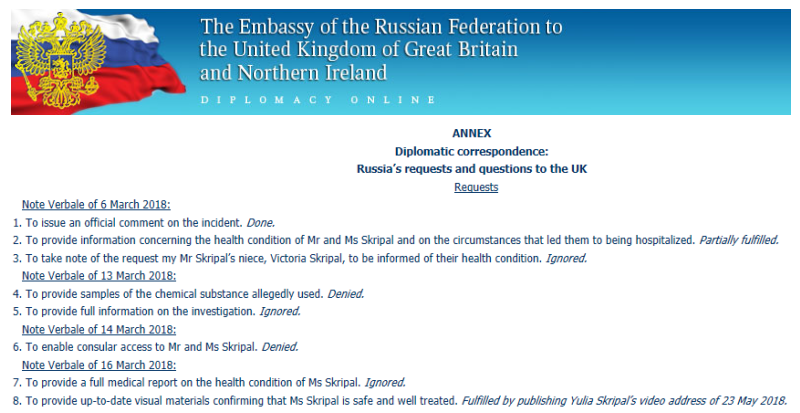
TO ENLARGE IMAGE, CLICK TO PRINT
Excerpt of report by the Russian Embassy, “Salisbury: Unanswered Questions”, first released March 4, 2019. A London lawyer named Vikram Sachdeva, paid by the Home Office to represent the Skripals in court, concealed from the presiding judge these official communications from the Russian Government and from the Skripal family. Sachdeva refuses to answer questions about his misrepresentation in court.
The OPCW blood-samplers publicly announced on April 12, 2018, that they had matched the arms from which they drew blood to the faces of the two Skripals and that of Wiltshire policeman, Detective Sergeant Nicholas Bailey, from the official photo and name identification documents they were shown.
Clark, Murray and Jukes refuse to do this; their story was published on Monday here. The full story was published in the book, Skripal in Prison, released on February 13; click to read.
Murray was asked yesterday “if your silence this week on the Skripal-Bailey case is required by the terms of an official secrecy document you have signed, as your talkativeness to Mr Urban on that case in May 2018 was permitted by the same authorities. A simple yes or no will be appreciated.” Murray refuses to say.
New photographs have now become available to show the layout of the Radnor Ward ICU where the Skripals were treated – Yulia Skripal until her discharge from hospital on April 9, 2018; Sergei Skripal until his release on May 18. The pictures have been gathered by researcher Liane Theuerkauf. They reveal details of the positions of the nursing staff, the doctors, and the patients in Radnor Ward, and also the entry and exit door to the ward.
The pictures confirm that a large number of individuals, including visitors to other patients in the ward, must have witnessed the Skripals. In addition to Clark, Murray and Jukes, not one of these additional witnesses has spoken of what they saw, nor is talking now, after two years.
ILLUSTRATIONS OF THE RADNOR WARD INTENSIVE CARE UNIT OF SALISBURY DISTRICT HOSPITAL
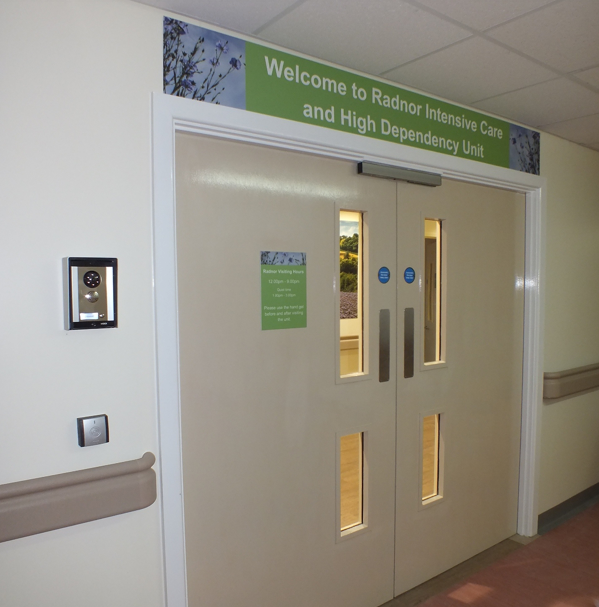
This is the sole entrance and exit for Radnor Ward; it is electronically locked and alarmed. An intercom device is installed on the wall, upper left; below it is a press-button bell signal for visitors to announce themselves to the unit chief on duty inside.
In March 2018 the police guard to prevent unauthorized entry into the ward, and to protect the security of the Skripals in their beds, should have been posted here. However, according to Detective Sergeant Bailey’s testimony to the BBC, he saw the police guard inside the ward treatment area. That position was installed to check the credentials of visitors to their bedside; intercept unauthorized communications with them; and prevent the Skripals from breaking out.
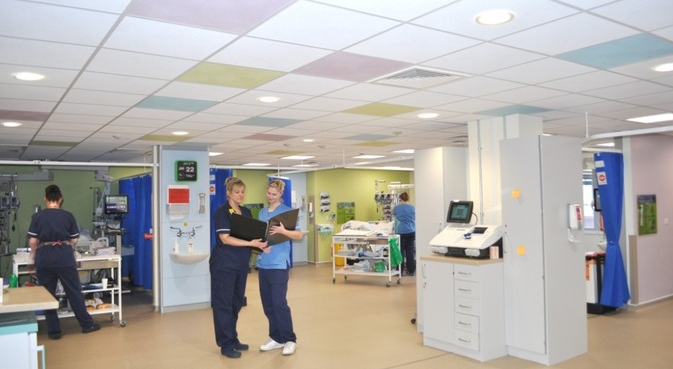
The central command and control area of the ICU,
after its renovation in January 2015.
Eight individual treatment units are located along the walls and can be curtained off for individual privacy. At least one nurse is assigned to each unit supervised by a senior sister. The openness of the area means that several nurses, equipment and laboratory technicians, and ICU doctors on shift duty – one consultant, one junior resident, and one trainee -- as well as visitors to other patients, were witnesses to the special medical and police measures reportedly surrounding the Skripals in March 2018, extending to April 9, 2018, for Yulia Skripal; and to May 18 for Sergei Skripal.
None of these witnesses has come publicly forward. Chief unit nurse Clark and the two treating doctors, Murray and Jukes, worked in this area. Murray told Urban early this month that he is still in charge of Radnor Ward.
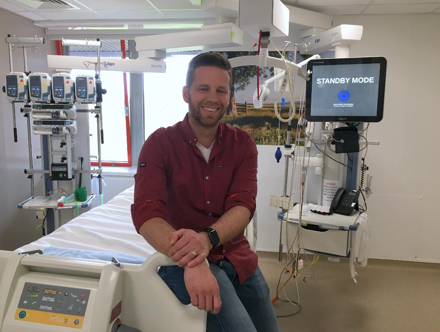
Det Sgt Bailey on one of the beds in the Radnor Ward ICU.
The photograph was published by SpireFM, a local radio and internet publication, on June 11, 2019, more than a year after his recovery and reported discharge from the hospital on March 22, 2018.
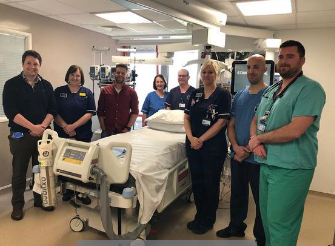
Det Sgt Bailey, third from left, in a photograph at the bed in
Radnor Ward with other members of the Ward staff.
The photograph was published by Bailey’s Twitter account on June 4, 2019, but then deleted. In a screenshot preserved by Liane Theuerkauf, Bailey wrote that he had just paid an “emotional visit to @SDHcriticalcare today where I met up with some of the wonderful nurses and doctors who cared for me. Also some great ideas about what to do with the fundraising money and how to make the Ward better for patients, families and staff. Truly #inspirational people”.
Seven members of the medical staff are pictured with Bailey, none of them the three who have publicly recorded their recollections of the Skripal episode. In February of this year, Faye Tryhorn, a reporter on the Skripal case at SpireFM and William Rimell, a reporter at the town newspaper Salisbury Journal, refused to answer questions about their coverage of the case and to report the new evidence.

The private-room row inside the Radnor Ward; the hospital plan of
the ICU indicates there are four rooms opening off this corridor.
Murray, a South African by origin, is identified in the Salisbury Hospital records as the clinical director of the Intensive Care Unit. He has continued public broadcasting on the BBC with Urban. According to the broadcast of April 7, focusing on the corona virus, Murray’s unit is responsible for taking over the severe respiratory failure cases from the first-stage Covid-19 admissions ward in the hospital. The latter has 60 beds, Urban reported on April 7.
When the Skripals and Bailey were reported to be in treatment at the ICU in March 2018, the ward had 12 beds – eight in the main ward area, 4 in the private room row. Urban now claims the unit has 20 beds. According to Urban, 14 of the Covid-19 infectious cases had died by the time of his broadcast out of “hundreds” of cases he reported as having been tested positive and admitted to the hospital – that’s a death rate of about 5%; the national UK death rate is currently running at 13.6%.
The case admissions, treatment and death rate data are a medical secret at the hospital, regulated by the NHS and the London authorities. These data are a medical secret at the hospital, regulated by the NHS and the London authorities.
Murray also disclosed publicly that he lacked confidence in the availability and reliability of the Covid-19 tests available for the hospital to test potentially infected doctors, nurses and others working at the hospital, and their families. This too is highly classified issue.
Murray was asked to explain why he discussed it openly on April 7 when, this week, he is refusing to clarify what he had already broadcast about the treatment of the Skripals and Bailey in March 2018. Murray still refuses to answer.
“I’ve been overwhelmed actually,” Murray said on air, “by umm, errr, the amount of people who have made contact with me and the offers of help made to me and my family to keep us going through what is likely to be a difficult period.”

No comments:
Post a Comment